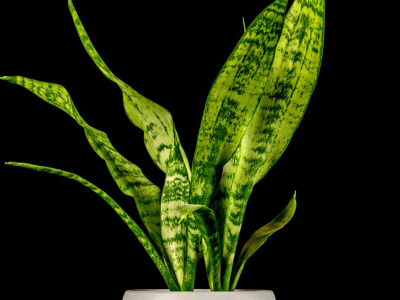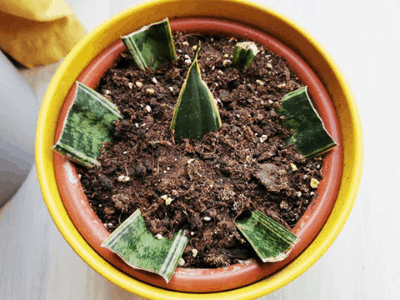If you are asked, “How do you propagate a snake plant?” what will be your answer?
Most probably you will say through cuttings or division, since they are the most common ones…
You can actually grow snake plant from seed, in case you haven’t know that yet…
Hear it from Yuri!
I’ve been propagating snake plants for several years…
… but I only use the division method because they have a greater percentage of success.
And I had proved that myself throughout these years…
But something shocked me, actually…
When I was scrolling through my go to online gardening shop…
I found that there are such thing as snake plant seeds!
I thought these foliage won’t have seeds, but they do!
But will they grow as good as those of other propagation methods?
Having the same query?

Here, we will try to take a look on the answer of that question…
It is possible to grow snake plant from seed! But do you even know about Sansevieria?
Sansevieria trifasciata, also known as the snake plant, has been discussed previously…
But we’ve never really looked into snake plant propagation, and it’s long past time…
So, today, we’ll take a look at the various methods for starting new snake plants…
Each has advantages and disadvantages, but they all result in an increase in your sansevieria collection!
Choosing Your Propagation Technique
Snake plant propagation can assist you in creating a lush foliage garden…
The first step in the rooting process is to decide on a method…
Propagation can be done in a variety of ways, just like most plants…
Certain methods are more trustworthy than others…
Let’s talk about the advantages and disadvantages of each method…
… as well as how to use it most effectively. In no time, you’ll be growing a slew of new plants!
Leaf Cuttings in Soil

By far the most common method, this technique uses a cactus-type potting mix as a rooting medium…
Begin by selecting a healthy, thick leaf. Choose one which looks perfect and vigorous, with no cosmetic damage…
While damaged leaves can take root, a healthier leaf produces a healthy plant…
About an inch above the soil, use sterile shears to cut the leaf off…
Measure out 2-3′′ long leaf segments with a ruler…
Cut them apart with care, leaving a clean flat edge…
Make a dot on each segment closest to the bottom of the original leaf with a pen…
This indicates which end of the plant to plant. Allow a couple of days for your leaf segments to dry…
This allows the cut edges to dry and scab over, reducing the chance of rot…
And then…
It’s time to plant them once they appear to be dry…
Fill small pots halfway with cactus mix, making sure it’s damp to the touch…
The bottom of each leaf segment should then be dipped in water and then rooting hormone…
This will aid in the development of the roots…
Insert the segment into the pot gently, about half an inch deep…
Keep your new cuttings in a bright, indirect light environment…
Check the soil every day or two, and water it again when it is nearly dry…
Ensure the pot isn’t submerged in water and remove any plant trays once the excess has been drained…
Unfortunately, when propagated this way or in water, some cultivars lose some of their unique characteristics…
The “Golden Hahnii” cultivar, for example, frequently loses its golden color and reverts to the “Hahnii” cultivar…
The “Moonshine” cultivar frequently reverts to its earlier “Robusta” form…
You may not get an exact clone of your parent plant if you’re growing an unusual variety…
Seed Starting: Is It Reliable?

It is true that snake plants can be grown from seed… Is it, however, worthwhile?
The majority of the time, the answer is no…
Many cultivars can only stay true to type by dividing their rhizomes and roots…
Seeds usually produce the original plant types that were used to create the hybrid, rather than the hybrid itself…
Seed germination rates are also unreliable…
At best, many snake plant seeds have a very low germination rate…
It is possible to start a plant, but if you require a large quantity, division or cuttings are preferable…
If you decide to start one from seed, make sure you get your seeds from a reputable source…
You’ll pay a little more for an established seed company, but you’ll have a better chance of germination…
Individual sellers’ seeds may not have been harvested properly…
Worse, there are numerous seed frauds out there…
Those seeds will not germinate, resulting in a significant amount of time and money being wasted!
If I had to suggest a foolproof method for propagating snake plants, I’d suggest division…
It’s usually best to split a single plant into two or three clumps, and they recover quickly…
Hopefully, the information provided above will assist you in expanding your snake plant collection in the future!
Another Way to Growing Your Snake Plant!
Leaf Cuttings in Water

Cuttings of snake plants can be rooted in water…
It’s a little riskier for your cuttings, but it’s not impossible…
If you’re rooting in potting medium, you’ll need a much longer cutting…
Aim for a 4-5′′ segment from the leaf’s tip…
Allow the cut end to heal over for a day or two, just as you would for a soil-based propagation process…
Fill a jar or glass halfway with clean, room-temperature water once it’s ready…
Check to see if it’s tall enough to hold your cutting without falling out…
Place your cutting in the water, making sure the cut end is submerged…
Replace the water in your jar every two days…
Clean your container once a week to make sure it isn’t growing algae…
Make sure you’re cutting in a bright, indirect light source…
Allow roots to form at the cutting’s base to grow to a length of at least two inches…
After that, you can transplant into moistened potting soil…
The biggest disadvantage of this method is the possibility of your cutting rotting…
Keep the majority of the cutting out of the water, allowing only the lower portion to sit in it…
Keep pests away from your young cuttings as well, as pest damage can be fatal during this delicate period…
Propagation by Division

If you have a mature snake plant that has not been repotted in a number of years…
… and has filled the pot with growth around the base of the plant…
… division is arguably the easiest method of propagation.
With these chunky white-colored tap roots, the pot can become contorted over time!
The solid green birds nest snake plant at the top (‘dracaena trifasciata hahnii’)…
… has started to produce offsets that can be separated to create a new plant…
… in snake plants with a more compact rosette form.
When propagating by division, make sure both ‘divisions’ have roots…
… if there is a larger tap root that can be chopped in half…
… this is a good idea and will give both new plants the best chance of survival.
Otherwise…
Having some sort of root system is usually sufficient + preferable to having none at all…
With the rhizome division method, propagating in a glass of water is not necessary. This will drown their roots. You only propagate a snake plant in a glass of water when there are no roots yet.
Linda Ly, plant expert and founder of Garden Betty
Furthermore, separating young plantlets without a sufficient root system can be difficult…
… unless the division is callus + water/soil propagated until roots form before planting up.
I’ve done it successfully before, but it’s not the most straightforward option in my opinion…
Propagation by Leaf Cuttings
Leaf cuttings are a slower method of propagation than division…
… but there are times when this is the best option.
A good example is chopping a leaf that has been damaged…
… or has begun to rot at the base but can still be saved by taking a cutting.
It’s worth noting that while it’s always preferable to take cuttings from a healthy plant…
… rooting a leaf isn’t impossible if you catch it early enough.
Simply cut a few inches above the damaged area…
I had two damaged leaves this winter, so I cut both of them and let them callus (more on this in a minute)…
One was fine and is now submerged, but the other was too damaged to save and became soggy…
Not all cuttings will germinate, so don’t take it personally if it doesn’t work out right away!
Before you start snipping, make sure the blade is completely sterilised…
… as the succulent nature of snake plant leaves makes them particularly susceptible to bacterial infections.
Sharp, clean cuts are always preferable to jagged cuts…
… made with a blunt scissors, which can result in soggy cuttings.
To sum it up…
See, having Snake plant is good choice for you to have!
It’s cool, its famous, it’s easy to have and care! What else do you need?
In this pandemic time like this, is a good choice for you to have an new activity…
… and having snake plant is a good choice for you to have!
Last thing for sure. This plant need to be care carefully, remember plant need the “love” too…
Conclusion
Alright that’s all for today! Do you have any questions about all of this?
Or do you want to add some method to grow snake plant from seed very well and healthy?
Let me know your recommendation from the comment below…
I hope you can now take care your snake carefully and grow it big!
Check out more posts in our website like this one here!
Thanks for reading this article! Contact us if you need any assistance…


